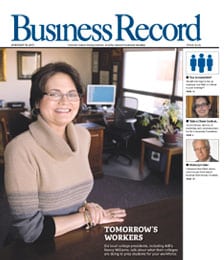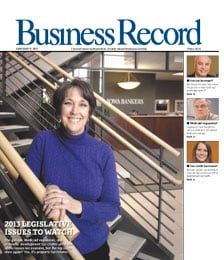Redefining downtown

The view out the window of her apartment on 15th Street and Woodland Avenue is nice most of the time. But at night, when the cubicles of Meredith Corp. are plainly visible, Rachel DeSchepper wonders if living within throwing distance of work is always a good idea.
“I guess that is the only bad part,” said DeSchepper, 22, who works as an associate editor of Meredith’s Country Home magazine. “I look out and see the cubicles and think about how I have to work tomorrow. But even that isn’t too bad. And being able to walk to work every day is really great.”
DeSchepper is among a growing number of residents who are forsaking the suburban life and heading back to Des Moines’ urban center. Since 2002, 37 new downtown housing projects have been started, built or proposed, according to a report by the Greater Des Moines Partnership. Tim Leach, vice president of economic development for the Downtown Community Alliance, said that as of March 16, 5,323 people lived downtown, defined as being in the 50309 Zip code. In the one-mile radius surrounding the heart of downtown Des Moines live more than 13,000 people.
“We believe this growth will continue for quite a while,” Leach said. “There will still be a very bullish downtown housing market for many years to come.”
Many of the people moving downtown are young professionals who are single, have no kids and want to live close to work, as well as where they play, Leach said, wanting to avoid long commutes to work that come from living in the suburbs.
“I like being close to everything I do,” DeSchepper said. “And all of my really good friends who are out of school either live downtown or really want to live downtown. So this is a great time in my life to be here.”
B.J. Knapp, an Iowa Realty agent handling sales at the Mulberry Lofts, said he has seen a wide spectrum of people moving downtown.
“You need the younger buyers to really re-energize downtown, but I’m seeing a lot of empty-nesters as well,” he said. “They move down here because the kids are gone and they don’t want to have to worry about taking care of a lawn anymore. So it isn’t just younger people just out of school buying their first home.”
Knapp said with downtown’s wide array of housing options, from smaller inexpensive condominium units and apartments to higher-end developments, that kind of mix of people is unavoidable and to the benefit of the city. Leach agreed, adding that downtown living is not exclusive to anyone.
“This is just a great time to get downtown,” said Jenny DeCarlo, 27, who is moving into the Mulberry Lofts in July. “There is just so much going on right now with night life, food and shopping that I definitely want to be close to.”
She also likes the idea of eliminating yard work from her life.
“That’s definitely a plus,” she said. “No lawn, no shoveling snow. Can’t say that wasn’t a major consideration.”
Building a community
Barbara Kirk understands why so many people are heading downtown. She did it herself 17 years ago.
“I just knew I wanted to be here,” said Kirk, who moved from West Des Moines into The Plaza, a high-rise condominium at 300 Walnut St. “Now I’m such an urbanite.”
Kirk said she walks nearly everywhere she goes now, putting less than 5,000 miles a year on her car.
“I fill up my gas tank once a month,” she said. “Everything is right at my doorstep, so I just really don’t need to drive. People were so jealous that I could walk to the [Des Moines] Arts Festival or that in the winter I can use the skywalk to get to the Civic Center.”
However, one of the main things Kirk loves about living downtown is the growing sense of community. Three years ago, the Downtown Neighborhood Association was formed. Since then, Kirk said the area’s residents are beginning to grow closer together.
“There was no neighborhood feel 17 years ago,” said Kirk, who serves as president of the neighborhood association. “I knew the people in my building but I didn’t know anyone from other buildings. Now, the association has socials that bring people together from all over the downtown area.”
And it’s probably the most diverse neighborhood in Des Moines, said Jeff Johannsen, president of J. Thomas Inc. in Urbandale and vice president of the Downtown Neighborhood Association.
“We have the broadest demographic of people in terms of income, ethnicity and age,” he said. “City, state and county government are our neighbors; they are housed in our neighborhood. This relationship becomes so important in planning and developing the neighborhood.”
Johannsen said people have a lot of misconceptions about living downtown, but those who have moved there know how rewarding it can be.
“We want people to know the cultural experience that living downtown provides, and that we are not a neighborhood that shuts down after 5 p.m.,” he said. “There are many exciting events and fun people living downtown.”
He agrees with Kirk that the area hasn’t always felt like a community.
“People in different buildings never thought of themselves as neighbors,” he said. “Now, people are getting together to create this unique little neighborhood.”
A lot of promise
Johannsen said when he moved into the Civic Center Court Apartments 10 years ago, there was not much happening downtown.
“There just wasn’t anything going on,” he said. “The promise was there, and the resources were there, but no one was doing anything.”
Now, Johannsen said, he can barely believe the amount of growth he’s seeing downtown in many different elements.
“Residential and commercial, obviously, but also biking and hiking paths, parks, trendy restaurants,” he said. “Living downtown puts you right in the middle of what’s happening.”
When Johannsen moved downtown, his business was located in the State Historical Building and he was running the Terrace Café. Several years ago he left the facility to focus on the catering and vending side of the business. But moving his business operation to Urbandale wasn’t completely sweet.
“I miss being downtown a lot,” he said. “I worked downtown for years, and it was really great. I miss being close to work like that. I know I’ll be back downtown again some day. My friends say nobody loves downtown as much as I do, and nobody promotes is as much either. What can I say, it’s just really is a great place.”
Kirk said the growth in downtown is evident in the membership of the neighborhood association, which has grown from 50 to 270 members.
Johannsen said he expects membership to reach 500 by next year.
“I’ve talked to a lot of people who’ve always lived in the suburbs and are dying to move down here,” Kirk said. “I don’t know if they can build fast enough.”
Knapp said the demand for downtown housing is huge.
“I get 20 to 30 inquiries a week about living downtown,” he said. “There are a lot of naysayers out there, but success speaks for itself.”
Following the trend
In most cases, Des Moines is usually five to seven years behind national trends, said Jake Christensen, one of five owners of the Liberty Building on Sixth Avenue.
“Around the country, people have begun moving back to the urban center,” he said. “It took a while, but Des Moines has finally caught on to that, and now there are great things happening downtown.”
Knapp said with the amount of money many national companies have invested in the downtown area, the downtown residential market will continue to expand for years to come.
“I don’t think there is any fear of overbuilding,” he said. “Companies are sinking a lot of coin into Des Moines, and they wouldn’t do that unless they were planning for the long term. Downtown will continue to grow and people will continue to come.”
Leach said the daytime population of downtown, or the number of people working in the area, is commonly given as 65,000. But according to Partnership figures, that number actually totals 73,557.
“With all that growth and that many people downtown, I don’t think we are anywhere near a slowdown in the downtown residential boom,” he said.
Leach said retailers are beginning to follow the people downtown, but what is exciting is it isn’t just catering to those who live in the area.
“Look at the East Village, or restaurants like Centro,” he said. “They are becoming destinations for people all over the city, not just for those living downtown. That is a really good trend.”
DeSchepper said being close to these attractions is one of the big selling points to being downtown.
“I was down here almost every weekend at the [Vaudeville] Mews, the East Village or at the Farmers Market,” she said. “Now I don’t have to fill up my gas tank nearly as much because everything is close by.”
The only thing she said she misses, other than occasionally missing a yard, is being close to a grocery store. This is a complaint many people have voiced, but Kirk said it usually comes from people who recently moved into downtown.
“No one walks to the grocery store,” she said. “Even in the suburbs you drive to get soap and detergent. You wouldn’t carry all your bags back to your house. It just doesn’t make sense.”
Getting away from the suburbs
“My parents joke that I’ll never live the way that they did,” DeSchepper said. “I grew up in suburbia, but I just can’t see myself living there. The suburbs just aren’t for me.”
Johannsen said the neighborhood association’s goal is to have 10,000 people living downtown by 2009. Many may feel this is unrealistic, but with the speed of growth, he thinks that goal may even be exceeded.
“There is just so much happening downtown right now,” he said. “And it’s only getting better.”
From her balcony in The Plaza, Kirk said she has seen a lot of development in the last couple of years, with much more to come.
“It’s exciting,” she said. “I’ve loved living downtown the whole time, but now that everyone else seems to be discovering, it makes it even better. There is just so much going on. I had no idea this would happen.”







